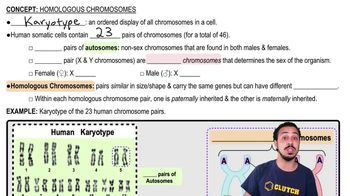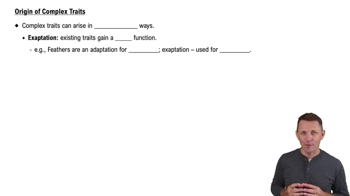Table of contents
- 1. Introduction to Biology2h 42m
- 2. Chemistry3h 40m
- 3. Water1h 26m
- 4. Biomolecules2h 23m
- 5. Cell Components2h 26m
- 6. The Membrane2h 31m
- 7. Energy and Metabolism2h 0m
- 8. Respiration2h 40m
- 9. Photosynthesis2h 49m
- 10. Cell Signaling59m
- 11. Cell Division2h 47m
- 12. Meiosis2h 0m
- 13. Mendelian Genetics4h 44m
- Introduction to Mendel's Experiments7m
- Genotype vs. Phenotype17m
- Punnett Squares13m
- Mendel's Experiments26m
- Mendel's Laws18m
- Monohybrid Crosses19m
- Test Crosses14m
- Dihybrid Crosses20m
- Punnett Square Probability26m
- Incomplete Dominance vs. Codominance20m
- Epistasis7m
- Non-Mendelian Genetics12m
- Pedigrees6m
- Autosomal Inheritance21m
- Sex-Linked Inheritance43m
- X-Inactivation9m
- 14. DNA Synthesis2h 27m
- 15. Gene Expression3h 20m
- 16. Regulation of Expression3h 31m
- Introduction to Regulation of Gene Expression13m
- Prokaryotic Gene Regulation via Operons27m
- The Lac Operon21m
- Glucose's Impact on Lac Operon25m
- The Trp Operon20m
- Review of the Lac Operon & Trp Operon11m
- Introduction to Eukaryotic Gene Regulation9m
- Eukaryotic Chromatin Modifications16m
- Eukaryotic Transcriptional Control22m
- Eukaryotic Post-Transcriptional Regulation28m
- Eukaryotic Post-Translational Regulation13m
- 17. Viruses37m
- 18. Biotechnology2h 58m
- 19. Genomics17m
- 20. Development1h 5m
- 21. Evolution3h 1m
- 22. Evolution of Populations3h 52m
- 23. Speciation1h 37m
- 24. History of Life on Earth2h 6m
- 25. Phylogeny2h 31m
- 26. Prokaryotes4h 59m
- 27. Protists1h 12m
- 28. Plants1h 22m
- 29. Fungi36m
- 30. Overview of Animals34m
- 31. Invertebrates1h 2m
- 32. Vertebrates50m
- 33. Plant Anatomy1h 3m
- 34. Vascular Plant Transport1h 2m
- 35. Soil37m
- 36. Plant Reproduction47m
- 37. Plant Sensation and Response1h 9m
- 38. Animal Form and Function1h 19m
- 39. Digestive System1h 10m
- 40. Circulatory System1h 57m
- 41. Immune System1h 12m
- 42. Osmoregulation and Excretion50m
- 43. Endocrine System1h 4m
- 44. Animal Reproduction1h 2m
- 45. Nervous System1h 55m
- 46. Sensory Systems46m
- 47. Muscle Systems23m
- 48. Ecology3h 11m
- Introduction to Ecology20m
- Biogeography14m
- Earth's Climate Patterns50m
- Introduction to Terrestrial Biomes10m
- Terrestrial Biomes: Near Equator13m
- Terrestrial Biomes: Temperate Regions10m
- Terrestrial Biomes: Northern Regions15m
- Introduction to Aquatic Biomes27m
- Freshwater Aquatic Biomes14m
- Marine Aquatic Biomes13m
- 49. Animal Behavior28m
- 50. Population Ecology3h 41m
- Introduction to Population Ecology28m
- Population Sampling Methods23m
- Life History12m
- Population Demography17m
- Factors Limiting Population Growth14m
- Introduction to Population Growth Models22m
- Linear Population Growth6m
- Exponential Population Growth29m
- Logistic Population Growth32m
- r/K Selection10m
- The Human Population22m
- 51. Community Ecology2h 46m
- Introduction to Community Ecology2m
- Introduction to Community Interactions9m
- Community Interactions: Competition (-/-)38m
- Community Interactions: Exploitation (+/-)23m
- Community Interactions: Mutualism (+/+) & Commensalism (+/0)9m
- Community Structure35m
- Community Dynamics26m
- Geographic Impact on Communities21m
- 52. Ecosystems2h 36m
- 53. Conservation Biology24m
32. Vertebrates
Chordates
Problem 16f`
Textbook Question
The size and shape of the vertebrate skull can reveal a great deal about an animal's lifestyle and evolutionary relationships. Consider your own skull. If you put your finger in your ear and move your jaw up and down, you can feel the space near the hinge of your jaw. Nestled in this space are the tiny bones that make your hearing possible: the malleus, incus, and stapes. All mammals have these three ear bones, but reptiles such as this T. rex don't.
Where did ear bones come from?
Evolution often results in the co-option of a preexisting structure for a new use. Cite three examples from this chapter to support this statement.
Evolution can also result in the loss of a trait. Cite three examples from this chapter.
 Verified step by step guidance
Verified step by step guidance1
Identify the concept of evolutionary co-option, which involves the adaptation of existing structures for new functions. This is a key principle in understanding the evolution of complex traits.
Review examples of evolutionary co-option from the chapter. For instance, consider how the jaw bones of early vertebrates evolved into the ear bones in mammals, demonstrating the repurposing of structures.
Explore additional examples of co-option, such as the evolution of feathers in birds initially for insulation or display, which later became adapted for flight.
Examine the concept of trait loss in evolution, where certain features may become reduced or disappear if they are no longer advantageous. This is another important aspect of evolutionary change.
Identify examples of trait loss from the chapter, such as the reduction of hind limbs in whales, which reflects adaptation to an aquatic lifestyle, or the loss of eyes in cave-dwelling species where vision is unnecessary.
 Verified video answer for a similar problem:
Verified video answer for a similar problem:This video solution was recommended by our tutors as helpful for the problem above
Video duration:
1mPlay a video:
Was this helpful?
Key Concepts
Here are the essential concepts you must grasp in order to answer the question correctly.
Evolutionary Co-option
Evolutionary co-option refers to the process where existing structures or genes acquire new functions over time. This can occur through natural selection, where a trait originally evolved for one purpose is adapted for another. An example is the evolution of mammalian ear bones from jawbones in ancestral reptiles, demonstrating how structures can be repurposed for new functions.
Recommended video:

History of Evolutionary Theory Example 1
Homologous Structures
Homologous structures are anatomical features in different species that originated from a common ancestor, reflecting evolutionary relationships. These structures may serve different functions in modern species but share a similar underlying anatomy. The presence of homologous structures, such as the forelimbs of mammals, birds, and reptiles, provides evidence for common ancestry and evolutionary divergence.
Recommended video:
Guided course

Homologous Chromosomes
Trait Loss in Evolution
Trait loss in evolution occurs when a species loses a characteristic that was present in its ancestors, often due to changes in environmental pressures or lifestyle. This can lead to the reduction or complete disappearance of a trait if it no longer provides a survival advantage. Examples include the loss of limbs in snakes and the reduction of eyes in cave-dwelling animals, illustrating how evolution can streamline organisms for specific niches.
Recommended video:

Origin of Complex Traits
Related Videos
Related Practice




























